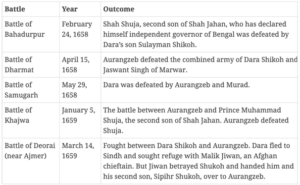- Home
- UPSC Mains
- Daily Free Initiatives
- Courses
- KPSC / KAS
- हिंदी
- Centres
- Contact Us
पाठ्यक्रम:
संदर्भ: दारा शिकोह को अक्सर औरंगज़ेब के दुश्मन के रूप में याद किया जाता है। 20 मार्च को दारा शिकोह की जयंती मनाई जाती है, जिनका जन्म 1615 में हुआ था।
पृष्ठभूमि: –
मुख्य बिंदु

उत्तराधिकार का युद्ध
स्रोत: Indian Express
पाठ्यक्रम:
संदर्भ : तेलंगाना विधानसभा ने अनुसूचित जाति (आरक्षण का युक्तिकरण) विधेयक, 2025 पारित किया, जिससे आरक्षण में अनुसूचित जाति के उप-वर्गीकरण का मार्ग प्रशस्त हुआ।
पृष्ठभूमि: –
मुख्य बिंदु
अतिरिक्त जानकारी
स्रोत: The News Minute
पाठ्यक्रम:
प्रसंग: अपनी “सॉफ्ट पावर” और मानवीय पहलुओं के अलावा, समुद्री कूटनीति संघर्ष को रोकने, हल करने और रोकने में मदद कर सकती है।
पृष्ठभूमि:
मुख्य बिंदु
हिंद महासागर क्षेत्र में भारत की भूमिका – समुद्री कूटनीति
रणनीतिक दृष्टिकोण की आवश्यकता
स्रोत: Indian Express
पाठ्यक्रम:
प्रसंग: तमिल साहित्य में सबसे महत्वपूर्ण कृतियों में से एक, कम्ब रामायण को संरक्षित करने और बढ़ावा देने के प्रयास में, संस्कृति मंत्रालय के तहत दक्षिण क्षेत्र सांस्कृतिक केंद्र (एसजेडसीसी) एक व्यापक पहल शुरू कर रहा है जिसका उद्देश्य ‘कम्ब रामायण’ के वाचन की मौखिक परंपरा को पुनर्जीवित करना है।
पृष्ठभूमि: –
मुख्य बिंदु
वाल्मीकि रामायण से तुलना:
विषय और महत्व
स्रोत: PIB
पाठ्यक्रम:
प्रसंग: बेतवा नदी गंभीर क्षरण का सामना कर रही है, जिससे जल स्तर में गिरावट आ रही है और पारिस्थितिकी संकट उत्पन्न हो रहा है।
पृष्ठभूमि: –
मुख्य बिंदु
महत्व
स्रोत: NDTV
दैनिक अभ्यास प्रश्न:
Q1.) दारा शिकोह के संबंध में निम्नलिखित कथनों पर विचार करें:
ऊपर दिए गए कथनों में से कौन सा/से सही है/हैं?
(a) केवल 1 और 2
(b) केवल 2 और 3
(c) केवल 1 और 3
(d) 1, 2 और 3
Q2.) बेतवा नदी के संदर्भ में, निम्नलिखित कथनों पर विचार कीजिए:
ऊपर दिए गए कथनों में से कौन सा/से सही है/हैं?
(a) केवल 1
(b) केवल 1 और 3
(c) केवल 2 और 3
(d) 1, 2 और 3
Q3.) कम्ब रामायण के बारे में निम्नलिखित कथनों पर विचार करें:
ऊपर दिए गए कथनों में से कौन सा/से सही है/हैं?
(a) केवल 1 और 2
(b) केवल 2 और 3
(c) केवल 1 और 3
(d) 1, 2 और 3
Comment the answers to the above questions in the comment section below!!
ANSWERS FOR ’ Today’s – Daily Practice MCQs’ will be updated along with tomorrow’s Daily Current Affairs
Q.1) – a
Q.2) – b
Q.3) – b
